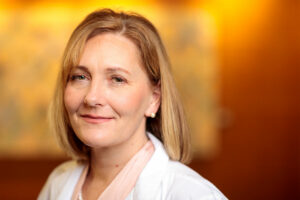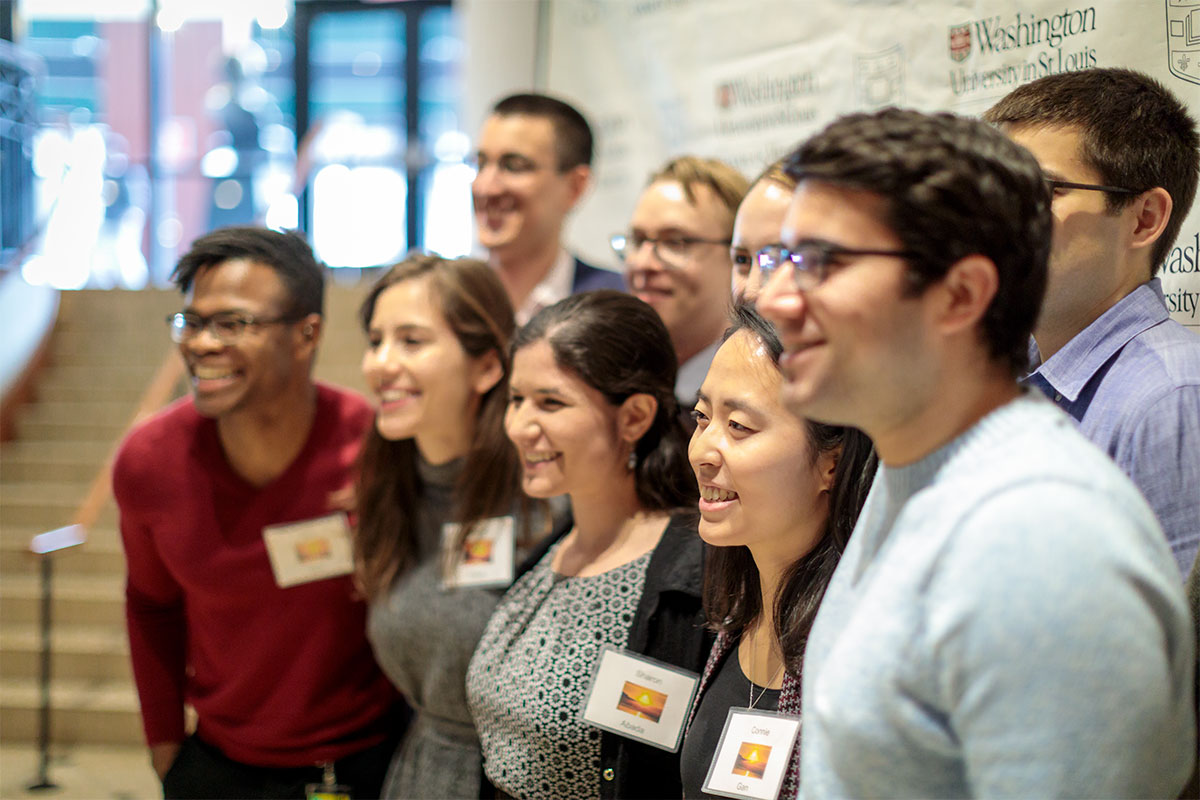New curriculum aims to improve physician training, benefit St. Louis
Leader Eva Aagaard’s focus on eliminating health disparities
 Matt Miller
Matt MillerIncreased community engagement will be a critical component of the new curriculum at Washington University School of Medicine in St. Louis. Laurie Punch, MD, (speaking) an associate professor of surgery, discusses her involvement in the community as a trauma surgeon who treats patients of gun violence. She spoke on a panel during a retreat on curriculum renewal at Busch Stadium on Jan. 17. More than 200 faculty and medical students and trainees attended the event.
Growing up in a racially and economically diverse neighborhood in Northern California, Eva Aagaard, MD, observed differences in the way society treated nonwhite, poor people.
In medical school in New York City during the early 1990s, she volunteered at clinics in low-income neighborhoods, helping the sick, hungry and homeless. She realized that people lacking access to basic necessities and health care were mostly African-Americans and Latinos.
During medical training in San Francisco, in the midst of the AIDS crisis, Aagaard learned that people who identified as homosexual and transgender often were marginalized by health-care providers, creating barriers to getting care. One patient — a young transgender woman dying of AIDS — still makes her misty-eyed. “Her body was emaciated, scarred and raging with infection,” recalled Aagaard, senior associate dean for education at Washington University School of Medicine in St. Louis. “She self-mutilated. She had been discriminated against and had limited resources. She died alone.”
Those experiences, and dozens like them, instilled a passion for addressing disparities in health care.
 Matt Miller
Matt Miller“It has guided my career path,” said Aagaard, the Carol B. and Jerome T. Loeb Professor of Medical Education. “Giving patients the health care they deserve means more than focusing on a single ailment or disease. It requires looking at the whole person, including their race, gender, sexual orientation, income, neighborhood, among other social and economic factors.”
Health-care workers call such disparities “social determinants of health.” Working to eliminate health barriers continues to serve as Aagaard’s professional North Star, one that led her to Washington University in 2017.
St. Louis offered Aagaard opportunities to combine her passions for medicine, academics and social justice. She was hired to revamp the medical school’s curriculum.
“Issues with equitable health care along racial lines are incredibly prevalent here,” she said. “It’s complicated, steeped in history and laws. I don’t pretend this can be solved easily. However, the medical school is overflowing with brilliant people who care deeply about doing the right thing. By revising the curriculum to intentionally address social and economic barriers to good health, we can build upon existing community and university partnerships, and develop new ones — all with the goal of improving the health of the St. Louis region and beyond.
“We can lead changes that need to happen here and nationwide,” Aagaard said. “St. Louis is ready. Washington University is ready. I’m ready.”
Known nationally as a leader in medical education, Aagaard long has been involved in realigning the training of medical students, first at the University of California, San Francisco (UCSF), where she served on the faculty, and, later, as associate dean for educational strategy at the University of Colorado. There, she was founding director of the university’s Academy of Medical Educators, which is geared toward nurturing physicians and scientists as educators.
Already, Aagaard helped initiate a similar group called the Academy of Educators, led by Mary E. Klingensmith, MD, the Mary Culver Distinguished Professor and vice chair for education in the Department of Surgery. That’s because professional development in medical education is a priority in curriculum renewal. One of the difficulties in academic medicine is that many physicians and scientists have no formal training as educators.
The last significant curriculum changes occurred 20-plus years ago. “Since then, the world has been transformed by technology, scientific discovery and our understanding of how best to teach physicians-in-training,” Aagaard said. “Incorporating this into curriculum renewal elevates our ability to produce leaders in human health.”
The new curriculum — called the Gateway Curriculum — is expected to begin at the start of the 2020-21 school year.
“Renewing our curriculum will allow us to remain a global leader in education, patient care and cutting-edge scientific discovery, while also advocating for the health of the St. Louis region,” said David H. Perlmutter, MD, executive vice chancellor for medical affairs and the George and Carol Bauer Dean of the School of Medicine. “Eva is known for excellence and innovation in academic medicine.”
 Matt Miller
Matt MillerReforming the curriculum is a monumental task that involves all aspects of the School of Medicine — from clinical departments and research labs to campus facilities to technology, support staff and more. In particular, faculty, fellows, residents and students are critical to developing and implementing the new curriculum, Aagaard said. Also key are campus partners such as BJC HealthCare, which includes Barnes-Jewish Hospital and St. Louis Children’s Hospital. These and other health-care centers serve as training hospitals for 1,200 residents and fellows, as well as medical students and allied health professionals.
“To ensure the success of curriculum renewal, we have invested significant resources in infrastructure, technology and, most importantly, faculty time to innovate and engage in the process,” Perlmutter added.
The process requires individual and institutional soul-searching about priorities, goals, science, medicine and teaching. It necessitates frank discussions about what currently works and what does not. Most important, curriculum renewal means embracing change.
“No question about it, change can be difficult,” Aagaard said. “Many faculty members have been here their entire careers. They’ve experienced major successes, and it can be hard to imagine alternative ways of doing things. I expect trepidation and even some resistance. Although, support from leadership, faculty, and students has been amazing.”
Perhaps it’s because Aagaard has involved them from the beginning. Besides questionnaires and focus groups, Aagaard has enlisted an advisory board of 45 faculty and students to research various curriculums at other medical schools. This inspired field trips to UCSF, Vanderbilt University in Nashville and Oregon Health & Science University in Portland to see how their recent curriculum overhauls have improved student training.
“The Medical Campus community has come together enthusiastically to collaborate on curriculum renewal,” said Amy Bauernfeind, PhD, an assistant professor of anatomy in the Department of Neuroscience. “We know it is crucial for remaining a top-rated medical school and research center.”
Bauernfeind serves as a co-team leader for a curriculum committee called Blue Skies, aimed at imagining out-of-the-box elements to foster innovation, scientific partnerships, academic flexibility, personal growth and community advocacy. “We were tasked with reimagining the curriculum without constraints,” she said. “Our premise became: What if we treated students like doctors the moment they arrived on campus?”
 Matt Miller
Matt MillerAnother committee, Greener Pastures, examined best practices in medical education, including at Washington University. “Our school has an excellent reputation because we do many things successfully,” said co-team leader Amanda Emke, MD, an assistant professor of pediatric critical care. “We want to preserve our strengths. It’s important to recognize that changing our curriculum should not imply that our current one is bad. But much has changed in our world, and we cannot be stagnant.”
Golden Horizons, the student-run committee, highlighted in-the-trenches perspectives and emphasized student wellness. “We’re excited to be at a top medical school,” said co-team leader Connie Gan, president of the Class of 2021. “But things could be more streamlined. For example, studying for medical boards is like a second job because we don’t get extra time to study. Or if we want to volunteer in community health care, we have to squeeze it within our already demanding school schedules.”
More than 200 people — including directors and representatives from every department — attended an off-campus retreat in January to hear presentations by the three committees, offer input and brainstorm ways to improve curriculum.
A popular theme that emerged from break-out groups included integrating basic sciences and clinical experiences throughout all four years of medical school. Currently, students’ first two years focus on basic sciences and the last two on seeing patients.
“The transition from second to third year is abrupt,” said Maren Loe, a third-year medical and doctoral student who serves on the Golden Horizons committee. “The first two years resemble being an undergraduate, and then — suddenly — in the third year, you’re almost a physician.”
Other ideas focused on identifying passions in science and medicine and expanding pass-fail grading options and mentorship.
“None of this is set in stone,” said Aagaard, explaining that assessing feedback from the retreat and Gateway Curriculum website is the next step. “We’re working on the blueprints for curriculum renewal, and blueprints can be modified.”
However, the overall foundation is solid. “Ensuring strong scientific underpinnings, training excellent physicians and addressing health disparities will serve as the pillars,” Aagaard said. “Compassionate medicine helps form professional identity. It prompts us to ask questions such as: ‘Who am I? What brought me to medicine?’ It inspires perseverance by reminding us why we chose medicine, which, for most of us, is to help people at vulnerable moments. The goal is to create a nurturing place for future physicians to use their brilliance and talents to provide the best medical care to patients while fighting against health disparities. We graduate approximately 125 physicians each year, plus we train thousands more.
“Over time, they can improve the world.”
 Matt Miller
Matt Miller





